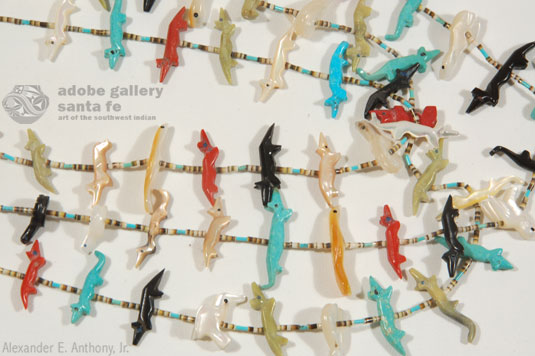Navajo Multi-stone Fetish Three-strand Necklace [SOLD]
+ Add to my watchlist Forward to Friend
- Category: Necklaces
- Origin: Diné of the Navajo Nation
- Medium: various stones - jet, coral, mother-of-pearl, turquoise, and abalone on shell and turquoise hieshe
- Size: 21-1/2” long
- Item # 25749 SOLD
Shortly after posting this fetish necklace, and labeling it as having been made by a Zuni artisan, we received a note from author Mark Bahti who wrote a book on Zuni fetishes called Spirit in the Stone: A Handbook of Southwest Indian Animal Carvings and Beliefs. Mark informed us that the origin of the necklace was not Zuni, but was Navajo. He identified the probable carver as someone from the Navajo carving family, Livingston-Yazzie, who worked for Frank Turpen and Stan Bartos in Gallup. After more research, we found the following information in John Kennedy’s book, A Good Trade: Three Generations of Life and Trading Around the Indian Capital Gallup, New Mexico.
“In the early 70s fetish necklaces were a rage. We could not get enough of them. The principal supplier was Frank Turpen in Gallup. He and his partner, Stan Bartos, had a business called Bear Toes. Their only products were fetishes and fetish necklaces. In a trailer at Gallup’s west end, they employed twenty carvers. Among them were Frank’s sons, Dewayne, Anthony, Ronnie, and Stacey. The boys also went by the name of Upshaw and are among the best carvers ever in the business…..
In addition, Frank had a surrogate son named Johnny Sheyka, who was Zuni and Navajo, who was instrumental in teaching Frank’s sons fetish carving. Fetishes became Frank’s hallmark in the business. When the jewelry boom was in full swing, Frank and Stan were supplying most of the fetish necklaces. They accounted for nearly 90% of the fetish necklace supply. They had a system. Each carver was good at carving a particular fetish like a bird, fox, or bear. Turpen’s sons carved everything well. As fetishes accumulated, Frank’s wife Eva and daughter Tanya strung necklaces with pleasing combinations of color and character, often with graduated strands. Their “signature” was a turquoise open-wing bird at the bottom of the necklace…..The best thing about their fetish necklaces, besides their quality and color, was that they were ready for sale. Zuni carvers sold the fetish individually. I then had to purchase heshi beads and have the necklaces strung.”
The fetishes on this necklace are very well carved, but the key identifier as one of Turpen’s carver’s work is the turquoise open-wing bird at the bottom of the necklace.

This exceptional *fetish necklace is comprised of three strands, each of a different length arranged in such a manner that each strand can be viewed without overlapping another. The longest strand contains 20 fetishes carved from jet, coral, mother-of-pearl, turquoise, and abalone shell. The middle strand contains 19 fetishes carved from the same stones and maybe others. The shortest strand contains 18 fetishes carved from similar stones. The fetishes are strung about an inch apart on shell and turquoise hieshe (or hieshi). The three strands are held together at their ends with silver cones and a silver clasp.
The fetishes are very well carved and are dainty. There are birds and animals mixed throughout the three strands. The arrangement of color is very pleasing.
Condition: this Navajo Multi-stone Fetish Three-strand Necklace is in very good condition
Reference and Recommended Reading: A Good Trade: Three Generations of Life and Trading Around the Indian Capital Gallup, New Mexico by John D. Kennedy
Provenance: from the private collection of a California woman
*What is a Fetish? Zuni [and Navajo] fetishes are small carvings made from various materials by the Zuni [and Navajo] people. These carvings have traditionally served a ceremonial purpose for their creators and depict animals and icons integral to their culture. As a form of contemporary Native American art, they are sold with secular intentions to collectors worldwide.- Wikipedia
^What is Hieshe or Hieshi? it is made from either turquoise or seashell. The shells are first cut into small square sections, drilled in the center, strung on wire or string, then sanded by hand, in an up and down stroke, until each one is round. That sounds easy but is not. It is important to exert the same pressure on every stroke to achieve hieshe of the same diameter when finished. The shell is punched out in a square shape, hole drilled though center, strung, and then sanded to the diameter it needs to be. According to the Indian Pueblo Cultural Center, the beaded tradition is most closely associated with Santo Domingo Pueblo, known for creating beautiful shell and gemstone beads by hand. These beads are called "heishi," which means "shell" in the Santo Domingo language Keres. Necklaces with similar bead styles have been found in the ancient Anasazi sites Chaco Canyon and Mesa Verde, and heishi may be the oldest form of jewelry in New Mexico. Traditionally, heishi beads are smooth flat discs, but today the term is used to refer to any small beads that are strung together.

- Category: Necklaces
- Origin: Diné of the Navajo Nation
- Medium: various stones - jet, coral, mother-of-pearl, turquoise, and abalone on shell and turquoise hieshe
- Size: 21-1/2” long
- Item # 25749 SOLD



